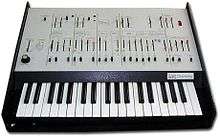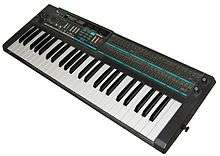Paraphony
Paraphony is a term used in musical vernacular to refer to consonances which rely upon intervals of fifths and fourths. This terminology can be traced to ancient Greece and sources such as Theon of Smyrna.[1]
"Paraphonic" on synthesizers
Outside of academic musical circles it is also used to describe the property of an electronic musical instrument that can produce multiple notes or voices, but falls short of being truly polyphonic.[2] This is the result of the voices not being fully independent, since they share at least one common element. For example, there might be a single filter working on all voices collectively, rather than the one filter per voice schema of truly polyphonic instruments; or there might be one Envelope generator.
One well-known paraphonic synth is the Korg Poly-800, which had 8 oscillators and could produce 8 voices, or 4 of 2-oscillator voices, but had just one filter.


In common parlance however, musicians may refer to synthesizers capable of playing more than two notes simultaneously as "polyphonic". A synthesizer which can play only two notes at the same time, like the ARP Odyssey (or possibly Oberheim Two Voice), is known as "duophonic". Despite having only one VCF (voltage controlled filter), for example, the Korg Mono/Poly is widely referred to as a "polyphonic synthesizer".[3]
References
- ↑ pg. 417 of "Apollo's Lyre: Greek Music and Music Theory in Antiquity and the Middle Ages" By Thomas J. Mathiesen, published by U of Nebraska Press
- ↑ SoundOnSound: Paraphony vs. Polyphony
- ↑ http://www.vintagesynth.com/korg/mopo.php

